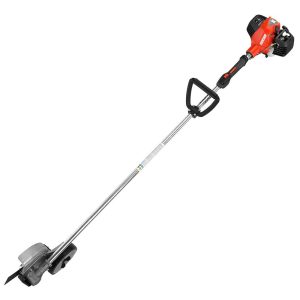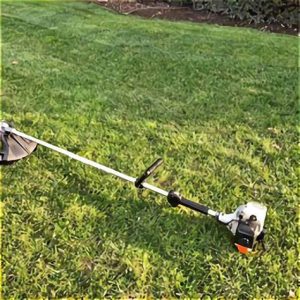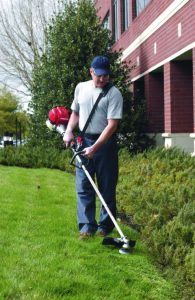Troubleshoot Six Typical Issues With Craftsman Chainsaws
To keep your chainsaw in good working order and reduce the likelihood of problems, regular maintenance is essential.
If your saw develops a defect, you must fix it before using it again so that it does not cause more harm and is safe to use. To aid you in diagnosing and fixing your chainsaw, I have compiled a set of troubleshooting charts and links to additional information.
The Craftsman operator’s manual contains important safety information that should never be ignored. The spark plug wire must be removed and the engine allowed to cool completely before any maintenance can be done.
Common Issues with the Craftsman Chainsaw:
- Chainsaw won’t start
- Chainsaw starts, stalls, and dies
- Chainsaw Chain Is Stuck and Won’t Turn
- Chainsaw only runs with the choke on
- Chainsaw loses power and bogs down
- Chainsaw is smoking
Before diagnosing, repairing, or operating, be sure you’ve read and understood all of the safety recommendations in the equipment’s operator’s manual.If you don’t feel confident in your ability to conduct the repair safely due to a lack of experience, training, or health, it’s best to call in an expert.
Table of Contents
Typical Craftsman Chainsaw Issues & Fixes
1. Craftsman Chainsaw Won’t Start
If your Craftsman chainsaw won’t start, check for obstructions that could prevent the engine from receiving the air, fuel, and spark needed for combustion.
Verify that a fuel mixture of 40 parts gas to one part oil is being used. Always use new fuel with an octane value of 89 or higher and no more than 10% ethanol.
Blend in some high-quality 2-cycle engine oil, such as this Craftsman brand.
Fuel stabilizers like Sea Foam can be added to new fuel to extend its shelf life.
| Cause | Reason for the Problem | Solution |
| Old or subpar fuel | Fuel degrades over time, becoming less effective and more likely to block fuel systems. | Drain the fuel tank, then refuel it with 2-cycle oil and new gas. Mix at a 40:1 ratio. To stabilize the fuel and help clean the fuel system, use a fuel additive like Sea Foam. Choose the proper fuel. |
| Insufficient 2-cycle oil | An improper mixture may be unable to give the engine the lubrication it needs. | At a ratio of 40:1, combine gas and 2-cycle oil. Use fuel with no more than 10% ethanol and a minimum 87 octane rating. |
| Faulty spark plug | The engine may not start due to a dirty or damaged spark plug, a loose spark plug wire, or an improper gap. | Secure connections, swap out the spark plug for a new one, and make sure the gap is set as directed by the manufacturer. |
| Air filter plugged | A dirty air filter may obstruct airflow. | Clean the filter by removing it. If the filter is in poor shape, replace it. |
| Fuel filter clog | Fuel flow will be impeded by a dirty fuel filter. | Switch out the fuel filter. |
| Obstructed gasoline lines | Old fuel and dirt deposits may clog the fuel lines and prevent the engine from receiving fuel. | To free the obstruction from the fuel line, use compressed air and a carburetor cleaning. The line may be changed if necessary. |
| Gasoline tank vent clogged | A blocked gasoline tank vent prevents the tank from venting. Fuel will be prevented from escaping the tank by a vacuum that forms. | Unclog any gasoline tank vents that are blocked. |
| Spark arrestor plugged | When the spark arrestor is blocked by carbon, hot air cannot leave the chainsaw. | Spark arrestor screen should be removed and cleaned. |
| Unclean carburetor | Bad fuel and ethanol deposits can clog the carburetor and cause it to get unclean. | The carburetor’s components should be cleaned. If required, change it. |
| Bad starter bulb | The primer bulb will shatter and stop delivering fuel to the carburetor. | Switch out the priming bulb. |
| Inundated engine | The fuel-to-air ratio is operating too richly, preventing ignition. This may be brought on by repeatedly tapping the primer bulb or repeatedly drawing the starter rope with the choke closed. | Spark plug removed. the chainsaw should be turned over. You should not be facing the spark plug hole. 6 to 8 times on the starter. The spark plug should now be installed again. Fire up the chainsaw. |
| Defective starter recoil | The engine cannot start when the rebound is damaged or broken. | To see if the recoil can be re-strung, check it out. Broken components must be replaced. If necessary, swap out the recoil assembly. |
The same issues that prevent a Craftsman from starting are also likely to be the root of its inability to continue operating after it’s up and running.
After the engine has warmed up, you must move the choke to the open position or the vehicle will sputter and eventually stop running from a lack of air.
If your chainsaw starts but then sputters and dies, you should also inspect the fuel tank vent. The problem may be with the fuel tank vent if the saw starts running better after you unscrew the lid.
| Cause | Reason for the Problem | Solution |
| incorrect choke setting | After the engine has warmed up, if the choke lever is not moved to the open position, the engine will shut off. | To start a cold engine, close the choke to restrict air. Once the engine has warmed up, open it. |
| poor fuel | Fuel degrades with time, becoming less effective and more likely to clog fuel systems and harm engines. | Drain the gasoline tank, then refuel it with a 40:1 mixture of 2-cycle engine oil and fresh fuel. To help maintain the gasoline stable and keep the fuel system clean, use a decent fuel additive. |
| fuel filter clog | An obstructed fuel filter won’t let through enough gas. | Switch out the fuel filter. |
| gasoline filter plugged | Insufficient gas won’t be able to pass through a clogged fuel filter. | Change the fuel filter. |
| dirty fuel lines | In order for the engine to receive the necessary fuel, bad gasoline deposits and dirt might accumulate and choke the fuel lines. | To unclog the gasoline line, blow it out with compressed air and a carburetor cleaning. Fix a damaged fuel line. |
| unhealthy carburetor | Bad fuel and ethanol deposits that block fuel flow can cause the carburetor to get dirty and clogged. | Make sure the carburetor’s parts are completely clean. If required, rebuild or substitute. |
| unreachable fuel tank vent | The gasoline tank vent cannot be used if it is blocked. Fuel won’t be able to leak out of the tank since a vacuum will build. | Fix a fuel tank vent that has clogged up. |
| Spark arrestor with a plug | The spark arrestor can become blocked with soot, preventing hot air from venting. | Clean the spark arrestor screen with a metal brush after removing it. Change a damaged screen. |
3. Craftsman Chainsaw Chain Is Stuck and Won’t Turn
There’s a chance the chain can’t go around the bar easily anymore. For obvious safety reasons, you should never touch the chain unless the spark plug wire is first removed.
Next, check for loose links in the chain or damaged bars. Lubricate the chain and the bar, and replace any worn clutch pads.
| Cause | Reason for the Problem | Solution |
| The chain brake is activated. | The chain brake is a safety measure that, by halting the chain in the event of a kickback, lowers the risk of injury. | To prevent the chain brake from engaging, make sure it is moved to the back of the saw. |
| The bar and chain are not lubricated enough. | The chain on the bar may cease turning if there is too much friction and heat buildup as a result of inadequate lubrication. | Fill the reservoir for the bar and chain oil. Make sure there isn’t a blockage in the oil channel by checking. |
| The chain tension is excessive. | Although it should be able to move freely, the chain should fit snugly around the guide bar. There shouldn’t be a chain dangling haphazardly from the bar. | Spark plug wire should be removed. By loosening the bar holding nuts, you can adjust the chain. Maintain the bar’s nose up. Chain tension is adjusted by rotating the tensioning screw in either a clockwise or counterclockwise direction. |
| Wearing clutch pads | In order to turn the chain, worn clutch pads cannot engage the clutch drum. | Switch out the clutch assembly. |
4. Craftsman Chainsaw Runs With the Choke On
If the engine is getting too much air or not enough fuel, a Craftsman chainsaw won’t run unless the choke is engaged. To ensure that the gas/air combination ignites when the piston compresses it, the choke must be engaged.
More information is available at:
Craftsman Chainsaw Requires the Choke to Be Engaged (7 Reasons)
| Cause | Reason for the Problem | Solution |
|---|---|---|
| stale fuel | Varnish and deposits that result in fuel restrictions and fuel component failures can be left behind by old fuel. | Deplete the gasoline supply. Refill with brand-new gas and 40:1-mixed 2-cycle oil. Fuel system cleanser and a stabilizer for fuel are added. Start the engine and let the fuel circulate through the system. |
| leak in the fuel line | The volume of air that reaches the engine can be increased by sucking air into the line. | Fuel line replacement. Check for limits in the fuel line. |
| fuel filter clog | Airflow is hampered by a filthy, clogged air filter. | Switch out the air filter. |
| defective carburetor gasket | The carburetor may get overfilled with air if the gasket can no longer seal. | Replace the gasket after removing the carburetor. |
| unclean carburetor | Fuel tubes may clog and stop allowing enough gas for combustion to occur. | Clean the carburetor by removing it. If necessary, rebuild it or replace it. |
| gasoline tank vent clogged | A vacuum will develop in the fuel tank as a result of a blocked fuel tank vent. By doing this, fuel won’t leak from the tank. | Fuel tank vent should be replaced. |
5. Craftsman Chainsaw Loses Power and Bogs Down
When a Craftsman chainsaw suddenly loses power and stalls, a dirty carburetor is usually the blame. Because of old gas, the fuel line is clogged.
Make sure there aren’t any obstructions in the way of the air and fuel mixture. Make sure the chainsaw’s hot air can escape by inspecting the exhaust.
| Cause | Reason for the Problem | Solution |
|---|---|---|
| stale fuel | Varnish and deposits that result in fuel restrictions and fuel component failures can be left behind by old fuel. | Deplete the gasoline supply. Refill with brand-new gas and 40:1-mixed 2-cycle oil. Fuel system cleanser and a stabilizer for fuel are added. Start the engine and let the fuel circulate through the system. |
| air filter plugged | A clogged air filter prevents proper airflow from passing through. | Switch out the air filter. |
| dirty spark plug | An erratic spark might be brought on by a dirty spark plug. | Replace or clean the spark plug. |
| fuel filter clog | A clogged filter prevents the passage of enough fuel. | Switch out the fuel filter. |
| obstructed or damaged fuel line | Fuel may be prevented from reaching the carburetor by clogged fuel lines. | Attempt to replace or clean the fuel line. |
| gasoline tank vent clogged | A vacuum will develop in the fuel tank as a result of a blocked fuel tank vent. By doing this, fuel won’t leak from the tank. | change out the gasoline tank. |
| Plugged spark arrestorspark arrestor plugged | Soot can block the spark arrestor, preventing hot air from venting. | The spark arrestor screen should be taken out and scrubbed with a wire brush. |
| The chain brake is activated. | A safety feature called the chain brake is used to stop the chain in the case of a kickback. | Activate the off position on the chain brake. |
| unclean carburetor | Fuel tubes may clog and stop allowing enough gas for combustion to occur. | To get rid of the varnish that old fuel left behind, clean the carburetor. If required, rebuild it or get a new one. |
| Carburetor has to be adjusted. | For optimal performance, the RPMs at idle and full throttle might need to be changed. | Utilize the operator’s manual’s recommendations to adjust the carburetor. |
6. Craftsman Chainsaw Is Smoking
When the bar and chain of your Craftsman chainsaw begin to smoke during usage, you should inspect the area for sources of increased friction.
The engine and exhaust could be emitting smoke. There could be water in the gasoline, the air filter is clogged, or the improper fuel combination is to blame.
| Cause | Reasons for the Problem | Solution |
|---|---|---|
| Dull chain | When using a chain that has been dulled or improperly sharpened, more force must be used. Friction gets worse under pressure. | hone a rusted chain. If you are unclear of how to properly sharpen the chain for safe use, have it done by a professional. |
| Tight chain | When the chain is unable to travel freely around the bar, friction and smoke develop. | Change the chain after removing the spark plug wire. |
| Bar and chain oil tank is empty. | When there is not enough oil, friction increases. | Add bar and chain oil to the tank. |
| faulty bar and chain oil | If the oil is too thin, the bar won’t stick to it enough. | Use bar and chain oil of good quality, such as these oils from Craftsman and Oregon. |
| obstructed oiler | When the oiler is blocked, oil cannot lubricate the bar and chain. | Oiler cleanup. |
| air filter plugged | A clogged filter will result in a rich fuel combination, which will produce smoke. | A highly unclean air filter should be changed. Regularly check and clean it. |
| the fuel mixture contains too much oil | Extra oil is used in Craftsman vehicles. The chainsaw may smoke when using a 40:1 fuel mixture. | Fill the tank with the proper 40:1 fuel mixture after draining the old fuel. |
| The fuel mixture contains water. | White exhaust smoke can be produced by water. | Drain the fuel and replace it with 40:1 new gas and oil in the tank. |
Never Neglect to Maintain Your Craftsman Chainsaw
You may expect your Craftsman chainsaw to break down at some point, just like the rest of your outdoor tools.
Keeping up with routine maintenance and using clean fuel will extend the life of your saw and make it less likely that any issues would arise.
To keep your Craftsman chainsaw in top shape, I advise servicing it thoroughly once a year.
The air filter, fuel filter, and spark plug are all replaced at each year’s service. The fuel and cooling systems, as well as the exterior, should be inspected.
Make sure all screws are securely fastened and replace any worn or broken components. The chain needs to be checked for wear and tear before every usage.







